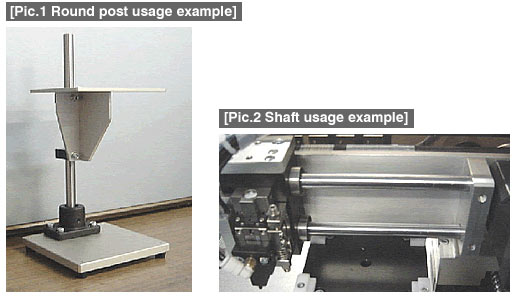#001 Pictorial and Explanations on LCA Standard Components : How to Select Standard Components
MISUMI's FA Mechanical catalog contains many components with similar appearances. However, they differ in design specifications such as material, surface treatments, dimensional tolerances and shaft-end configurations.
= Example: Case of [1] Shafts, [2] Rotary shafts, [3] Rods, and [4] Posts / Stands =
Explanation
our groups above have the similar appearances but with different functions
| ・ | [1] Shafts and [2] Rotary shafts are motion mechanism components as moving parts. | |
| ・ | [3] Rods and [4] Posts / Stands are structural components as non-moving parts. | |
| ・ | For the motion mechanism components, material and surface treatments can be specified for durability, and tolerances for dimensional accuracy can be specified. |
[Comparison table of four product groups]
|
![[Pic.1][Pic.2]](http://www.misumi-techcentral.com/tt/en/lca/images/0001_1.gif)
Organizing LCA mechanisms
The LCA is comprised of the following configuration, and this establishes the reference for the components' functionality.
|

Structural member is: Non-moving mechanical elements that support the entire mechanism. Drive mechanism is: Moving mechanical elements. In order to make proper product selections from the catalog, it is important to understand the specific characteristics of the listed components. We will explain the characteristics of the standard components using visual information such as photos and pictorials, hereafter. Usage examples of shafts will be explained with pictorials next.
- Positioning technology
- Designing and processing
- Sensor Technology
- Automation elements technology
- Clean room technology
- Design hints
- Design tips
- Designing and Machining
- Drive mechanism design
- Hints on designing
- Linear Motion Components
- Locating Technology
- Manufacturing technology
- Motion mechanism design
- Pneumatic Drives
- Production Technology
- Technology Outlook
- General description
- Low-cost automation and materials
- Transfer LCA
- #333 Know-how on automation: Pressurized heating technology - 5: Multilayer pressurized heating process technique
- #332 Know-how on automation: Pressurized heating technology - 4: Points to remember when designing mechanism of pneumatic pressurization method
- #331 Know-how on automation: Pressurized heating technology - 3: Pneumatic pressurization method and pressure profile
- #330 Know-how on automation: Pressurized heating technology - 2: Pressurization method and pressure profile
- #329 Know-how on automation: Pressurized heating technology



